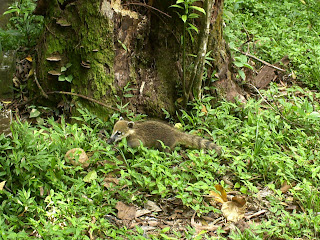
There’s a limit to the amount of Buenos Aires any man can take. Our satiation point showed up on the radar after one-and-a-half days… But don’t despair, there’s a fantastic bail-out option available: just imagine a place far enough away to be almost in a different century, but close enough for the tops of the Argentinian sky-scrapers to be just visible, allowing for the curvature of the earth. Another country, another world, another pace of life, another steak!
You can always rely on the good ol’ Buquebus high-speed catamarans to carry you across the broad Rio de la Plata. Due to the phenomenal speed of these vessels, we were able to travel from Argentina to Uruguay in just over an hour. But not just any place in Uruguay! We have really fallen on our feet here, what with the tiny, UNESCO renowned ex-smuggling village having retained the historical scenery and charisma that it’s had since 1682 when it was founded by the Portuguese.
By morning, it’s still fairly sleepy apart from the stray dogs patrolling their marked territories along the narrow cobbled streets and expressing their dominance to other dogs with a few loud barks and the occasional blood-curdling growl. The really keen people are disassembling piles of chairs and setting up their cafés for daily trading whereas the more laid back remain in their doorways drinking ‘yerba mate’, a kind of strong tea where the cup is overflowing with ground up, usually dried and decayed, off-green, tea leaves. This must be drunk through a type of metal straw that sometimes has a coiled end resembling a spring, which acts as a filter so it’s just tea that they drink.
By afternoon, the town earns it’s status of being awake where we see more liveliness in both people and animals alike. The dogs we mentioned have stepped up from chasing their canine neighbours to running along side trespassing cars, barking their heads off as they do so. They don’t seem to have a soft spot for the classic nor the vintage models either and they threaten each automobile relentlessly. The cafés and restaurants start to fill up with locals and tourists, and we notice the interested climbing the lighthouse and scaling the old fortress’ walls.

By evening, nobody starts to eat until the eight o’ clock mark although many don’t start dining until as late as midnight. The restaurants are the only real signs of life at night and as we stray away, we find ourselves in the eerie, yet homely tranquillity of the crazy paved streets that take light from the old, Dickensian-style street lamps. As one walks down these lonely streets, where the only noises emerge from hidden crickets and the gentle breeze from the nearby river, it becomes a real backwards time travel experience as we combine all this with the single storey, stone houses of various colours and the blossoming trees (many of which are bougainvillea) , and even the occasional prickly cactus. In places the pavements are piled high with firewood, and the many quaint, old cars seem to be not just for show, but actually for chugging around in!


As it was time for our evening meal, we decided to get out of the touristy restaurant quarter and stray off down a dimly lit side street where there were only Uruguayan people eating. At ‘El Asador’ the restaurant owner was very welcoming and we chatted, in our improving (but still very broken) Spanish about ‘Argentina’s got Talent’, which was on the television at the time; English football; and finally about how bloody brilliant the meal was! In Argentina and Uruguay, the ‘ll’ sounds as a ‘ssshh’ and so the name of the amazing charcoal or wood barbeque flaming in each restaurant is pronounced “parrrreesshah”. It’s kind-of obligatory to order from it! We ordered the ‘Parrilla para dos personas’, which turned out to be a huge mountain of steaks of various cuts. We both agree that rare steak is the best way to go, but we did forgive him for dishing out medium-rare as it was still award-winning. The various cuts of meat, including various ribs and some flank, arrived with its own charcoal burner to keep it warm as we chomped away. The French fries had been deep-fried in something heavenly-tasting. The cerveza was massive, but it all went down, gradually.

The intense heat of the day was dissipated around dusk by some dramatic thunder and lightening, and a welcome downpour accompanied by deep grey, moody skies. The lush evening felt like a release after the closeness earlier; by morning the rain was in abeyance, yet the clouds remained and a powerful southwesterly wind blasted off the river. At El Torreón, we sat cooling off and staring out across the water, admiring the ancient rafters made from driftwood and the walls of rough-hewn stone.

























